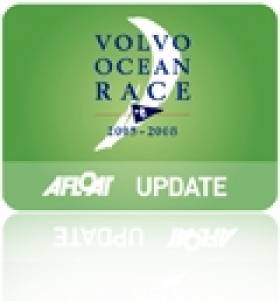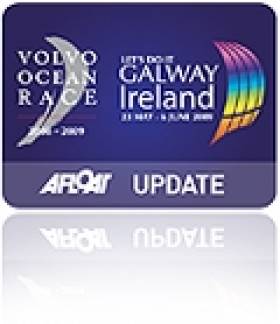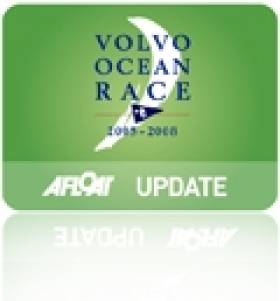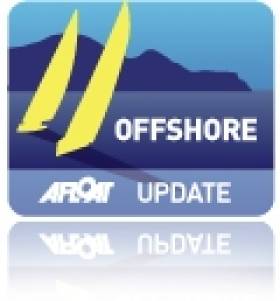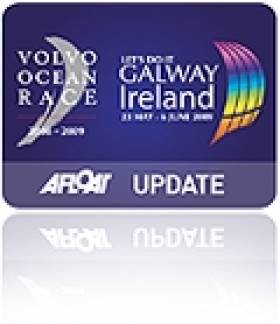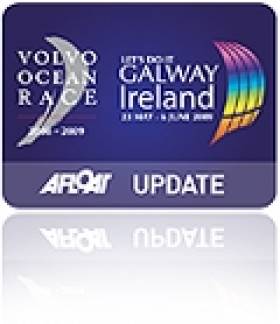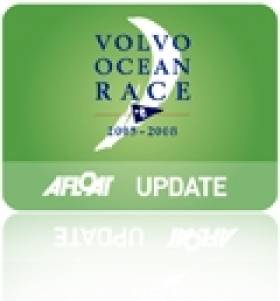Displaying items by tag: Galway
Watch Live Stream of the Volvo Ocean Race Galway Leg Now
#VOLVO OCEAN RACE - The final leg of the latest Volvo Ocran Race from Lorient to Galway is starting now - and you can watch the live stream of the action HERE.
Yesterday's Bretagne In-Port Race saw French team Groupama - which features Ireland's Damian Foxall on deck - clinch a dream home win, edging them closer to overall victory.
But as the Kerryman said just a few days ago, that victory is by no means assured, with 500 miles of turbulent Celtic Sea lying between the fleet and the finish line.
#vor – Tradtional boating got a boost at the Volvo Ocean Race in Galway last night at a special ceremony in Galway Harbour when the country's newest community built Galway hooker was named in a ceremony attended by Social Protection Minister, Joan Burton TD. The boat has been named 'Croí an Cladaig'.
The 32–foot boat is the first of its class to be built in Galway since 1922. In keeping with the Claddagh's centuries old traditions it will be launched on Sunday afternoon, after it is blessed in a ceremony conducted by Dominican Fathers.
The new hooker took 18 months to design and build as part of a training scheme organised by the Claddagh based boatmen's association, "Badoiri an Cladaig", FAS, Galway City & County Enterprise Board and several other local community groups.
Chairperson of "Badoiri an Cladaig", Michael Coyne, said the building of the new hooker has created huge excitement in the Claddagh and has given new impetus to efforts to revive the ancient craft of traditional boat building in Galway.
#VOLVO OCEAN RACE - Local businesses in Galway have committed to Fáilte Ireland's Quality, Value and Service charter for the Volvo Ocean Race festival that kicks off this weekend.
According to the Galway Advertiser, shops, eateries and accommodation throughout Galway have agreed to maintain high standards of quality and be transparent in their pricing to guarantee an enjoyable experience for the thousands of visitors who will be thronging the city over the next few days.
Minister for Tourism Leo Varadkar said the so-called 'Galway Guarantee' is "a great initiative to ensure that anyone visiting [the VOR] has a great time, and hopefully decides to return.”
The charter is a cornerstone of the ‘Your Volvo - Your Opportunity’ initiative designed to ensure that the City of the Tribes makes the most of the eight-day festival of sailing, culture, arts and food.
The Galway Advertiser has more on the story HERE.
#VOLVO OCEAN RACE - Damian Foxall hopes it will be fourth time lucky in his quest to clinch a Volvo Ocean Race victory - but as he tells the official VOR website, he won't be resting on his laurels.
Despite the overall 23-point advantage held by his team Groupama - following a dramatic comeback victory in the most recent leg of the race - Foxall says victory is not yet assured in a field that has been growing increasingly competitive in recent weeks.
"Now we have to keep pushing," says the 42-year-old Kerryman. "“We have a very fast boat if not the fastest boat in the fleet, and we've learned how to sail it very well. There is no reason we can't win this race. We've believed that from the start and now everyone else believes it."
But the watch captain and his crew are acutely aware that it can all be lost in the blink of an eye.
"A technical hitch or a couple of poor starts like we have had recently from Lisbon and it all goes down the drain," he says. "We can't let that happen.”
This Sunday the fleet departs on the final leg of the race, a 550-mile sprint from Lorient in France to Galway through the often turbulent Celtic Sea that has the potential to scupper even the best prepared team's plans.
The official Volvo Ocean Race website has more on the story HERE.
#rockall – The three boats competing in the first ever Round Rockall race from Galway are due back in the West coast port sometime tomorrow after an epic 750 mile race. All three yachts - two Irish and one German- rounded Rockall around midnight on Tuesday.
The German yacht "Bank Von Bremen" first made a 1,000 mile trip from its homeport of Bremerhaven to come to Galway for the race around Rockall. It has a crew of nine and is skippered by Rainer Persch.
The two Irish boats are being raced by veteran single-handed sailors Jamie Young, from Killary in Connemara and Barry Hurley from Cobh in Cork.
Barry Hurley is sailing his JOD 35 "Dinah" the boat in which he won his class in the 2009 OSTAR the singlehanded 3,000 mile transatlantic race from Plymouth in England to Newport Rhode Island in the US. He completed the crossing in what race organisers described as "a flawless 21 day run"
Jamie Young has taken to the seas in his classic Admiral's Cup 50 foot Frerer's designed "Killary Flyers". He competed in the 1976 OSTAR Race and he and his wife Mary spent their honeymoon completing a two handed transatlantic crossing. He now runs the Killary Adventure Centre in Connemara.
Race organiser Larry Hynes said "The idea of a non stop race around Rockall came about because of the enormous buzz created in Galway by the 2009 Volvo Ocean Race stopover. We thought we would like to do something spectacular to coincide with the 2012 Volvo Ocean Race finale and we ended up sending three boats racing around Rockall"
"The crews of the three boats are certainly taking the hard route to the party but they will certainly be given a great welcome home when they arrive back in the city tomorrow"
Volvo Ocean Race Galway Chief Lambasts 'Unfair Sniping'
#VOLVO OCEAN RACE - Miriam Lord's "sniping" on the Volvo Ocean Race and Global Village festivities in Galway was "unfair, unwarranted and misunderstood", according to the chair of the event organisers.
In a letter to the editor of The Irish Times, Enda O'Coineen (currently racing Green Dragon in the Round Ireland race) of Let's Do It Global took to task the political writer and satirist's article in last Saturday's edition of the paper, in which she opined about the VIP nature of some of the week's corporate hospitality events.
"'Sniping' at a critical time like this damages the work of a small core of professionals and almost 2,000 volunteers making it happen in the heart of Galway," wrote O'Coineen.
"Much of the hospitality is for international corporate visitors who bring business. Our ambition is, once again, to deliver a massive return on investment for our North Atlantic island residents and diaspora."
The VOR Galway head invited the Irish Times writer to "come to Galway and share the vibrance, the energy, the fun and adventure" of the week from 30 June to 8 July.
Lord herself has yet to respond to O'Coineen's comments, but we'd expect something just as wry as her columns.
#VOLVO OCEAN RACE - The Volvo Ocean Race finale in Galway will be a homecoming of sorts for specialist nautical map designer Bobby Nash, as the Irish Examiner reports.
The designer, who works at home in Kinsale, enhances classic charts of any harbour, sea, ocean or lake.
Nash first made his mark the last time Galway hosted a VOR stopover, when his commissions of artistic charts of Galway Bay and the Aran Islands were featured prizes in the in-port races.
"By layering several identical charts, he makes painstakingly-produced, hand-made 3D charts which literally bring the standard 2D charts to a new dimension — and they now travel all over the world," writes the Examiner's Tommy Barker. "He’s had over 1,000 chart commissions, many for multiple copies."
With the latest edition of the round-the-world yacht race, Nash's family-owned business Latitude has had an even bigger profile, as his charts - some of which taking many days to make - have been presented to each of the nine host ports.
And that's not all, as his upcoming prizes for Cowes, Falmouth and the Palma Superyacht Cup show how much his work is sought after.
The Irish Examiner has more on the story HERE.
Free Mobile App for Visitors to Volvo Ocean Race Galway
#VOLVO OCEAN RACE - Silicon Republic reports that researchers at NUI Galway have created a free mobile app for visitors to the city during the Volvo Ocean Race festivities starting this weekend.
Graduate students at the university's Digital Enterprise Research Institute (DERI) developed the app to provide visitors with up-to-date details of the festival programme from 30 June to 8 July - such as the slipway locations and dock gate opening times - as well as handy hints and tips for making the most of the City of the Tribes.
The DERI team have also integrated some of their own social technologies into the app such as 'Connect and Chat' and 'Tweet Cliques' so users can connect with their friends in the city.
The Volvo Ocean Race Festival Galway app is available from Apple's App Store and from the Google Play store for Android devices.
Silicon Republic has more on the story HERE.
#VOLVO OCEAN RACE - A Fine Gael senator last week called on the people of Galway to raise €100,000 for arts and culture events during the Volvo Ocean Race finale, The Irish Times reports.
Senator Fidelma Healy-Eames said the funding raised by event organisers Let's Do It Galway would be matched with €20,000 from the State by Arts Minister Jimmy Deenihan under a "philanthropy leverage initiative".
Private sponsorship has so far been slow off the mark for the week-long festivities surrounding the race conclusion, with the cost of events – including the biggest free open-air music festival of the year - expected to reach a total of €7 million.
#VOR – Craft on the water in the Galway bay area may be inspected by the Garda Water Unit according to a marine notice issued tonight by Galway Harbour Company setting out how pleasure craft are to behave during the Volvo Ocean Race finale from June 30th.
Galway Harbour Master Brian Sheridan who issued the notice says the 'safety of all while afloat during the Volvo Ocean Race Stopover at Galway is of prime importance'.
The notice also prohibits the use of tenders or dinghies to get ashore from a swinging mooring instead a Water Taxi service should be used.
In accordance with the Maritime Safety Act 2005, the Garda Water Unit will be paying particular attention to lifejacket use, vessel seaworthiness, vessel insurance and alcohol abuse.
The Irish Coast Guard will continue to monitor the following VHF Channels on Galway Bay: Ch 16, 67, 04 & Digital Selective Calling DSC70.
The full notice is available for download below as a pdf document.




























